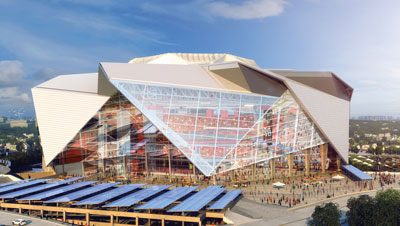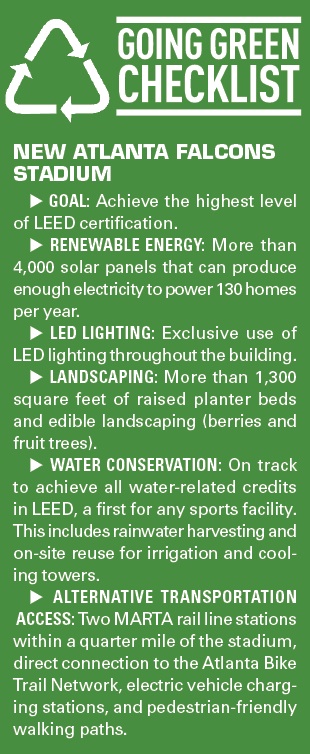The Atlanta Falcons are pointing to LEED Platinum for their new stadium. It would be a first for a big league facility to earn the highest level of certification under the U.S. Green Building Council’s program.
“We want to raise the bar,” said Scott Jenkins, general manager of the $1.4 billion stadium and board chair for the Green Sports Alliance, a group advocating green practices in facility development and operations.
“It’s too early to say where that bar’s going to be,” Jenkins said, “but right from the beginning, our intent is to get as many points as we can get. Platinum is what we aspire to. I won’t know until [the stadium opens in 2017] whether we get there or not. I feel good about where we’re tracking.”
 |
Solar panels above a parking garage are part of the design.
Photo by: Atlanta Falcons |
To this point, Jenkins said he feels “100 percent confident we’ll achieve Gold.” Getting to the highest level, though, will come down to maximizing LEED points tied to the site, water and energy, said Chris DeVolder, sustainable design leader for HOK, the stadium’s architect.
On the energy front, the stadium has a retractable roof, and it can be “naturally ventilated” when the roof is open, saving energy and providing a nicer fan experience, Jenkins said. The Falcons intend to keep the roof open as often as possible for both NFL and MLS games.
“We can open it and let it breathe,” Jenkins said. “It is more efficient. We want to be an outdoor stadium.”
In addition, the Falcons will stand out for installing LED lighting through virtually the entire stadium, including back-of-house spaces and field lighting. In general, LED lights use half the energy of conventional lighting and last 10 times longer.
Across the board in all leagues, the LED sports lighting trend is gaining momentum as teams and facilities recognize the cost savings connected to the technology. There’s less glare and during an event, LED lights can be turned on and off instantly, which increases the team’s ability to upgrade entertainment productions, Jenkins said.
“We’re lucky in that lighting is changing,” he said. “At some point, people won’t even talk about LEDs because
everything will be LED. Fortunately, we’re about two years from opening and are able to take advantage of the innovation. It’s a no-brainer to invest in it.”
Installing LED lights costs 25 percent to 40 percent more than traditional metal halide lights. The savings in electricity and maintenance result in a payback of five to seven years depending on how much the lights are used, Jenkins said.
The Falcons’ project is on track to achieve all water-related credits under the LEED program, which would be a first for a sports facility, team officials said. The list includes water efficiency inside the stadium, and rainwater harvesting and on-site reuse for irrigation and the cooling towers tied to the building’s HVAC system.
The stadium site sits in the Proctor Creek watershed, a tributary of the Chattahoochee River in western Atlanta. It’s similar to other big cities that have developed over time that “just kind of ignored the natural water system and paved over a lot of land and built a lot of buildings,” Jenkins said. As a result, it was critical for the Falcons to form a comprehensive storm water management plan to guard against flooding.
When it opens, the stadium will have the ability to capture 2 million gallons of storm water, most of it through a 1 million-gallon underground vault. Separately, a 680,000-gallon cistern above ground will capture rainwater to reuse for the cooling towers.
Jenkins can point to industry colleagues in drought-stricken California as an example for the importance of those massive structures in water conservation.
“Water shortages are generally regional, and it wasn’t long ago Atlanta was in a severe drought and the lakes were in serious trouble,” he said. “We’re blessed now to not be dealing with that. But water costs a fair amount of money, and who knows when the next drought is. The solutions make sense in an area that isn’t suffering because of the economics and just being environmentally responsible. It’s a high priority for us.”
For the Falcons, another part of the water story is edible landscaping tied to 1,300 square feet of planter beds and berries and fruit trees planned for the site. The small urban farm is part of the team’s educational program to encourage children to eat healthier foods.
“We will have 65 percent more points of sale than the Georgia Dome with more cooking capacity,” Jenkins said. “We have the infrastructure, the next phase is to develop menus. We’re going to look to develop locally sourced food. We can do some of that on site.”
The downtown site earns valuable LEED points in the transportation category. It’s sandwiched between two stops on the Metropolitan Atlanta Rapid Transit Authority rail line. Currently, 25 percent of Falcons fans travel by MARTA to games at the dome.
Team officials expect an even higher percentage of soccer fans to use MARTA — drawing from a younger crowd going to more weekday games with fewer tailgating opportunities. An expansion MLS team will begin play at the stadium in the spring of 2017.
The parking garage adjacent to the stadium will contain 4,000 solar panels, generating renewable energy. Despite state legislation in May eliminating $5,000 tax breaks for owners of electric cars, the Falcons plan to install 38 charging stations for those vehicles, Jenkins said.
On the sponsorship side, the Falcons are in discussion with potential partners tied to recycling and other green initiatives. Sustainability has resonated with local corporations and it’s helping to drive value for future deals, Jenkins said. To date, no deals have been announced.





